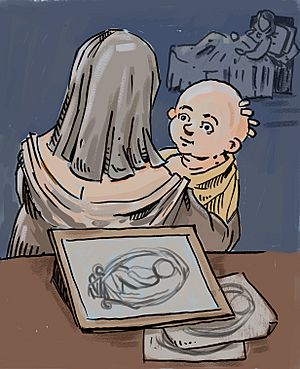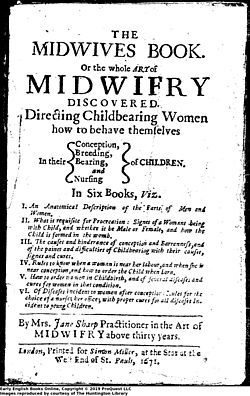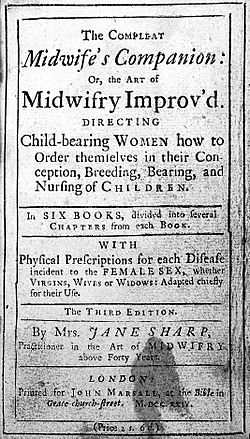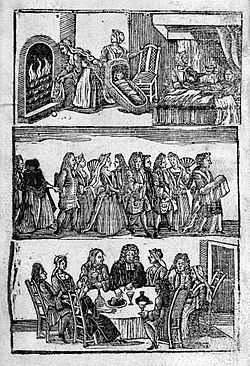Jane Sharp facts for kids
Jane Sharp (born around 1641, died 1671) was an English midwife. A midwife is a person, usually a woman, who helps mothers during childbirth. Her book, The Midwives Book: or the Whole Art of Midwifery Discovered, was published in 1671. It was the first book about midwifery written by an Englishwoman.
Contents
Who Was Jane Sharp?
We don't know much about Jane Sharp's life, except for her famous book. She was likely born in 1641 in Shrewsbury, a town in Shropshire, England.
On the title page of her book, she said she had been a "practitioner in the art of midwifry" for over 30 years. People believe she worked in London. However, her name doesn't appear in official records of midwives from that time.
Some people think Jane Sharp might have been a Puritan. Puritans were often more educated than other groups, which would explain why she could write. Her ability to write and travel suggests she might have come from a well-off family. We don't know if she went to school. It seems she had a daughter or daughter-in-law named Sarah Sharp.
Because so little is known about her life and death, some wonder if "Jane Sharp" was a pseudonym. This means it might have been a made-up name used by women writers back then.
What Did a Midwife Do?
Jane Sharp claimed to have worked as a midwife for 30 years. In her time, midwives learned their skills through practice, not formal schooling. Midwifery was one of the few jobs women could have.
Even though men started to enter the field, most people believed childbirth was a job for women. Most births happened at home, with a female midwife in charge. Jane Sharp gave practical advice, like suggesting women use a comfortable, upright position during labor, perhaps in a birthing chair.
Sharp's writings also covered medical topics. While women were often midwives, men usually became doctors or surgeons after formal education. She wrote for women about their health, using both medical knowledge of the time and her own experience.
The Midwives Book: A Guide for Women
The first edition of The Midwives Book came out in 1671. Later versions were printed in 1674, 1724, and 1725. The book was quite long, about 95,000 words. It cost two shillings and sixpence, which was a fair amount of money back then. This suggests it was meant for wealthier people or professional midwives.
The book started with a direct message to "The Midwives of England." Jane Sharp wrote that she was sad to see women suffer because of "unskilful Midwives." She explained that she had spent a lot of money translating books from French, Dutch, and Italian. She combined this knowledge with her own experience to help other midwives.
The first edition was dedicated to Lady Elleanour Talbutt, who was connected to a powerful family in Western England. This also suggests Jane Sharp had some important connections.
- Editions of The Midwives Book
What Was Inside the Book?
The Midwives Book taught women how to get pregnant, stay healthy during pregnancy, prepare for childbirth, deliver a baby, and care for the mother afterward. It was a guide for midwives, but also for anyone wanting to learn about the human body.
Most midwifery books at the time were written by men. Some of these men had never even seen a baby being born! Sharp's book focused on practical steps. She also used her guide to share her ideas about women's education and male midwives. She wrote in plain language, avoiding "hard words" that were difficult to understand.
The book was divided into six main parts:
- I. Anatomy of the Body: This part described the male and female body parts and how they work in reproduction.
- II. Getting Pregnant and Pregnancy Signs: It gave advice on how to conceive a child. It also explained signs of pregnancy and how a baby forms inside the womb.
- III. Fertility and Pregnancy Challenges: This section offered tips to help with fertility. It also covered how to care for pregnant women and deal with difficulties during childbirth.
- IV. Preparing for Labor and Baby Care: This part guided women on how to get ready for labor. It also explained the roles of midwives and parents, and how to care for a newborn.
- V. Managing Childbirth and Women's Health: This section taught midwives how to handle different situations during childbirth. It also covered how to care for women with health issues during pregnancy and delivery.
- VI. After-Birth Care and Baby Health: This final part focused on care for the mother and baby after birth. It included advice on feeding the baby and breastfeeding techniques.
How Jane Sharp Wrote Her Book
Jane Sharp used medical knowledge from her time. She also wrote in everyday language. This helped women training to be midwives learn surgical and medicine techniques. This meant they didn't always have to rely on male doctors during difficult births.
Sharp also used a method called commonplacing. This was like creating a scrapbook of ideas. She included notes, quotes, and information from other sources. This allowed her to combine existing academic knowledge with her own practical experience.
For example, she discussed old ideas about the body from famous thinkers like Aristotle and Hippocrates. They believed a woman's menstrual blood fed the baby. Then she talked about newer ideas that said menstrual blood poisoned the baby. Sharp used her own observations to correct both theories. She asked, "if the child be not fed with this blood what becomes of this blood when women are with child?" By doing this, she showed that practical experience was just as important as academic knowledge.
Jane Sharp's Strong Beliefs
Jane Sharp's book mixed medical facts with her own stories. She strongly believed that midwifery should be a job for women. This was at a time when more men were becoming midwives. She encouraged female midwives to learn surgical skills themselves. This way, they wouldn't need male doctors when problems came up.
She argued that men's knowledge from universities might sound impressive. However, it often lacked the real-world experience that female midwives had. She pointed out that some male authors, like Nicholas Culpeper, admitted they had never even seen a birth.
Sharp stressed that the best medical helpers combine practice and experience with medical texts. She famously wrote, "It is not hard words that perform the work... Words are but the shell, that we often break our Teeth with them to come at the kernel."
She believed women were naturally suited for midwifery. She knew men had better access to education. But she felt they lacked practical understanding. She wanted female midwives to become fully independent and handle emergencies themselves. She also noted that "women cannot attain so rarely to the knowledge of things as many [men] may, who are bred up in universities."
Other Midwifery Books of the Time
Jane Sharp used ideas from other books, like Nicholas Culpepper's A Directory for Midwives (1651). But she corrected mistakes and changed the tone to fit her own protofeminist views. This means she had early ideas about women's rights and abilities.
Before Sharp's book, most midwifery manuals in England were written by men. These authors often had no practical experience. They relied on old Greek texts or other books written by inexperienced men.
The introduction to a 1999 edition of The Midwives Book said that even though Sharp's book was similar to male-written ones, her details created a big change in how gender was understood.
Jane Sharp's Lasting Impact
The Midwives Book offered valuable advice during a time when midwifery was changing. It was very popular and likely found in many homes in the 1700s. It remained an important source of information about women and childbirth for a long time.
The children's novel The Midwife's Apprentice by Karen Cushman, published in 1991, features a character inspired by Jane Sharp. This book even won the Newbery Medal in 1996, a major award for children's literature.





